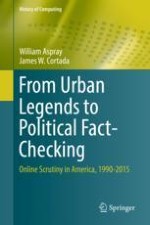2019 | OriginalPaper | Chapter
2. From Debunking Urban Legends to Political Fact-Checking
Authors : William Aspray, James W. Cortada
Published in: From Urban Legends to Political Fact-Checking
Publisher: Springer International Publishing
Activate our intelligent search to find suitable subject content or patents.
Select sections of text to find matching patents with Artificial Intelligence. powered by
Select sections of text to find additional relevant content using AI-assisted search. powered by
